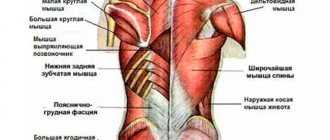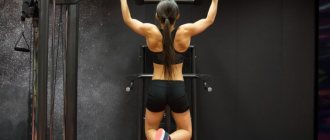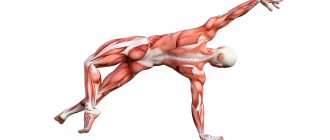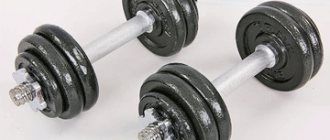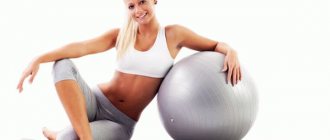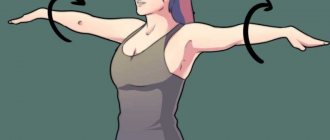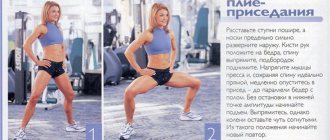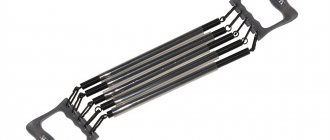A strong back with well-developed muscles is not only visual attractiveness, but also good health.
Proper training designed to work the muscles can normalize posture, increase physical endurance and prepare the body for more intense activities.
Exercises for pumping the latissimus dorsi muscles can be performed not only in a well-equipped sports club, but also at home.
Is pumping at home effective?
Pumping the back muscles at home is suitable only for those people who want to gain strong, developed muscles. If a person wants to get the same back as popular bodybuilders, then home fitness will not be enough, since independently purchasing the equipment necessary for serious pumping is unprofitable and impractical.
If a person intends to train without visiting the gym, then each lesson must be organized correctly.
How to train your back muscles at home without a gym or a trainer:
- Exercises should be given 2 days a week, maintaining equal intervals between workouts. Exposing your body to stress every day is not only pointless, but also harmful to health. Muscle grows during the process of rest from training. If you do not leave time for recovery, then the muscles will not increase in volume.
- When training your back, you should choose up to 4 effective fitness techniques for one complex: 2 with dumbbells, 2 with your own body weight. It is recommended to repeat each of them 15 or more times in each approach.
- It is forbidden to start working with large loads without preliminary muscle and joint warm-up.
- To prevent muscles from quickly becoming accustomed to physical activity, new fitness techniques must be included in each complex. It is desirable that they have a more complex execution technique than the previous ones.
Important! It’s important to start every lat workout with or without dumbbells with a few basic pumping exercises.
By training at home, you can simulate a strong back if you pay attention to the latissimus, trapezius muscles and erector spinae.
Be sure to check out:
Royal posture for girls: pumping up the back muscles at home Effectively pumping up the back: exercises for everyone Back geometry: pumping up the trapezius muscle Behind a wide back: pumping up the back muscles at home and in the gym
Who needs to strengthen their back muscles and when?
It can be said without exaggeration that performing exercises to strengthen the muscles of the back and spine is recommended for absolutely all people. Any doctor or trainer will confirm this. According to statistics, up to 40% of people begin to experience back problems by the age of 30. At the age of 45, this number increases to 50-60%, and after 55 years it reaches almost 75%. Such depressing figures are associated with the gradual degradation and wear of intervertebral discs.
Another reason is that not all people do gymnastics to strengthen the muscles of the back and spine. This worsens muscle tone, increases stress on the vertebrae and aggravates age-related problems. Therefore, the average age at which back problems begin is constantly decreasing.
The sooner you start worrying about strengthening your back muscles, the longer you can delay the appearance of problems (unfortunately, you won’t be able to completely avoid them; this is one of the main signs of “wear and tear of the body”). Classical fitness does not always solve the problem. And given the fact that most athletes do not follow the correct technique, back problems can only get worse.
Exercises for pumping up
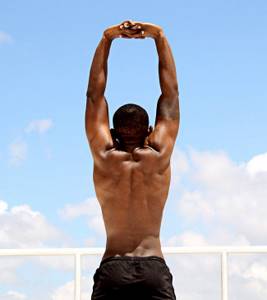
To effectively pump up your back muscles, you need to know the anatomy of this area, including:
- Latissimus muscle: it provides inward rotation of the arms and is also responsible for bringing the limbs to the body. The muscle is also responsible for tilting the body.
- Trapezius: responsible for moving the shoulder blades and tilting the head back.
- Spinal erectors: provide extension of the body.
You can build strong muscles in the back of your body with a variety of exercises. To perform fitness techniques you will need dumbbells and barbells. For loads with your own body weight, you will need a crossbar.
With dumbbells
The best exercises with this apparatus:
- The one-arm dumbbell row is an effective fitness technique that can be performed at home. During the load, the latissimus and teres major muscles work. To perform a deadlift, you need to stand at a horizontal support. The leg standing next to it should be bent at the knee joint and placed on a support. The other, outer limb should be straight. The back needs to be straightened, making a slight deflection in the lower back. The body is tilted until its position is parallel to the bench. To take a position convenient for performing, you need to slightly bend the outer limb at the knee joint. Take a dumbbell of the required weight with the outer upper limb. You need to rest your other hand on the support. The limb with the projectile is straightened, relaxing the shoulder. After inhaling, hold your breath and pull the arm with the dumbbell up as far as possible. At the peak point, at which the shoulder blades almost close together, you need to linger, and as you exhale, return to the starting point.
- Bent-over dumbbell rows are another effective fitness technique for working your back muscles. Helps pump up the latissimus muscles. To perform an exercise with dumbbells at home without an instructor, you only need to bend your legs slightly at the knee joints, and lower your body with an arched lower back at a right angle. Afterwards, you need to take the shells of the required mass in your hands. With your elbows up, you need to lift the implements until your shoulder blades come together. Afterwards, you need to smoothly return to the starting position.
Dumbbells effectively pump the latissimus muscles.
With a barbell

If you have a barbell at home, you can practice the following fitness techniques:
- Bent-over barbell rows – Outside the gym, you can practice bent-over barbell rows. This fitness move requires proper execution as it involves lifting heavy weights. First you need to stand in front of the projectile. Feet should be shoulder-width apart and knees slightly bent. Leaning your body forward, you need to take the bar of the projectile with an upper grip. The distance between the upper limbs should not be too wide. With straight arms you need to lift your body. To begin the actual exercise, you should bend slightly at the lower back and tilt your torso forward. The legs should be slightly bent at the knee joints. Deadlifts are performed only when the muscles of the lumbar region are tense. After inhaling, you need to pull the projectile towards your stomach. At the same time, the elbows move back up without diverging in different directions. The top points of the elbow joints should be directed upward as much as possible. The projectile must be lifted exclusively by tensing the spinal muscles, otherwise the exercise will be ineffective. As soon as the bar is in the lumbar region, you need to exhale and smoothly lower the projectile.
- Bend the body forward with a barbell: a fitness technique that qualitatively develops the rectifiers, as well as the buttocks. To perform the exercise, you need to place your feet shoulder-width apart. Taking the projectile with a wide grip, you need to carefully place the projectile on the trapezius area. The back is slightly arched at the sacrum, and the body is straightened. After taking a deep breath, you need to lean forward, moving the pelvic area back. When the body comes in line with the floor, you should return to the starting point. At the peak of effort, exhale slowly.
The barbell works well on the trapezius and latissimus muscles.
Hyperextension
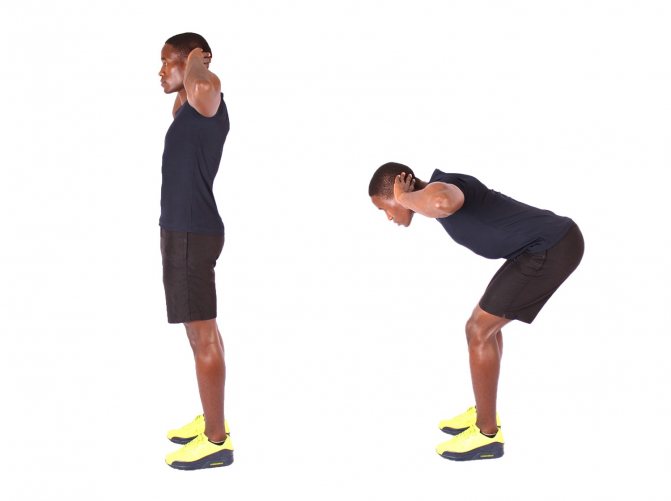
Hyperextension is a fitness technique that perfectly works the spinal extensors. Its essence is to pump up the muscles that stabilize the position of the spine. When performing hyperextension, the core works while the pelvis and legs are in a fixed position.
At home, you can perform the following types of techniques:
- With feet secured near the bed: To do hyperextensions without the appropriate sports equipment, you need to go to a bed under which you can fix your feet. Hands are placed behind the head. As you inhale, lift your body off the floor, pulling it as high as possible. At the maximum point, you need to exhale and return to the starting position.
- From a lying position without additional equipment: you need to lie on your stomach and extend your arms straight at your sides. As you exhale, you need to smoothly lift your body off the floor and pull it up. After the peak point, you need to return to the starting position by inhaling.
An additional benefit of hyperextension is that the fitness technique allows you to pump up your buttocks.
With its own weight

There are exercises for pumping up the back muscles, during which you have to work with your own body weight, using the muscles of the shoulders, arms and back. These include:
- Pull-ups: For this you will need a bar. Classic pull-ups are performed on a back pumping machine. First you need to hang on it correctly, placing your hands slightly wider than your shoulders. Then, bending your arms at the elbow joints, you should pull your chin towards the bar. At the peak point of effort, exhale and smoothly relax your arms.
- Plank (classic version): take a lying position, placing emphasis on your forearms. The legs rest on the toes. It is necessary to tense the abdominal muscles as much as possible, avoiding arching in the lower back. You need to stay in the straight line position for half a minute.
- Regular push-ups: first you need to lie on the floor, and then rise parallel to its level on straight arms and toes. At the same time, you should not bend at the lower back.
Exercise therapy for neck pain
Physical therapy helps reduce pain. Back exercises that strengthen various muscle groups are selected individually at different stages of the pathological process. In the acute period of the disease, when the patient is prescribed bed rest, he can perform short-term exercises - contraction and relaxation of the muscles of the trunk and limbs. Rehabilitators prescribe breathing exercises and leg movements without raising the feet. As the pain decreases, the patient can begin to walk slowly.
As the condition improves, doctors recommend performing resistance exercises. You can lie on your back and gently press the back of your head into the pillow. You need to stay in this position for 5 seconds, then you can relax. Alternately pressing the palm of your hand on the temple, we overcome the resistance of the neck muscles. The exercise should be performed in both directions for 5 seconds 3 times. We end each exercise with relaxation.
Without lifting your head from the pillow, press your forehead with both palms, overcoming the pressure with your neck muscles. We perform this exercise 3 times for 5 seconds. Then the patient sits on a chair and puts his hands down. He smoothly tilts it down, trying to press his chin to his chest. Under no circumstances should you throw your heads back.
Complex for working with the latissimus, trapezius muscles and erector spinae

You need to exercise muscles 2-3 days a week. On days free from training, the back muscles should be given a period to recover and increase volume.
It is enough to devote up to 40 minutes to a back set, doing each fitness move with minimal breaks.
An approximate complex for working on the back muscles looks something like this:
- one-arm dumbbell row in an inclined position – from 15 times in 3 cycles;
- Bent-over barbell rows – 10 times, 4 sets;
- forward bends with a barbell – 15 times, 3 sets;
- hyperextension – similar;
- pull-ups – 10 times, 3 sets.
This complex allows you to efficiently work out all the important muscles. Every week the number of repetitions in one set should be increased.
How to protect yourself from back injuries
Before starting your workout, you should perform light exercises to warm up your muscles, joints and tendons.
Then you need to stretch the spine:
- Lie on your stomach, placing your hands at chest level, and in this position bend back. Repeat up to 10 times.
- Standing half a step away from the wall, facing it, extend your arms as high as possible, then look up at your palms. Then place your outstretched arms on the wall and touch it with your chin and chest. If feeling of stretching of the spine , move a little further and repeat. At the end of the exercise, fix the pose and, turning your head, touch your back with each cheek in turn.
- Sit on a chair or stool with your head down. Clasp your hands below and pull your shoulder blades upward.
- Hang for two minutes on the horizontal bar, if there is no horizontal bar, on the interior door, lifting your legs off the floor.
Have you warmed up? Great. All that remains is to firmly grasp a simple safety rule: during the exercises, the lower back should be kept straight or slightly curved back.
Main conclusions
- To strengthen your back by pumping up your muscles, you can train yourself at home. To do this you will need dumbbells, a barbell and a bar.
- You need to focus on muscles 2-3 days a week for 30 minutes. Muscles will actively grow during the rest period from training.
- The latissimus muscle and trapezius are pumped by performing fitness techniques with equipment. The optimal technique for spinal erectors is hyperextension.
- The duration of one workout at home is 30-40 minutes. The essence of the lesson is to gradually increase the number of repetitions and approaches.
Training program
The training program depends on the presence or absence of iron and/or horizontal bar.
- If you have neither of these, do all the above exercises without equipment or iron, starting with two sets and adding one set every 2-3 months.
- If you have a horizontal bar, immediately add close-grip pull-ups for trapezius to your program, also 2 approaches. Start your workout with pull-ups, then do the rest of the exercises.
- If you have an iron with or without a horizontal bar and a large set of exercises is available: choose 6 exercises from the whole variety - 2 each for the upper, middle and lower back. Start with the ones you like best, and do everything in 2 approaches, and then increase the number.

